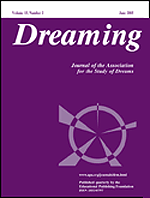 So far I’ve done word search analyses on 20 series of dreams from individuals and 9 sets of dreams from large groups of people, a total of more than 18,000 dream reports. It’s too early to say anything definite about the patterns that have emerged from this data. More reports need to be gathered from a wider variety of people, and more improvements need to be made in the SDDb word search template.
So far I’ve done word search analyses on 20 series of dreams from individuals and 9 sets of dreams from large groups of people, a total of more than 18,000 dream reports. It’s too early to say anything definite about the patterns that have emerged from this data. More reports need to be gathered from a wider variety of people, and more improvements need to be made in the SDDb word search template.
Still, a few basic patterns have appeared in nearly all the collections I’ve studied. I’m calling them ur-patterns because they seem to represent deep structural elements of dream content (ur- as in “original” or “primal”). That’s my general hypothesis, anyway, and each new set of dreams is another chance to test and refine it.
Here are the ur-patterns I’ve identified so far:
- Of the five senses, sight words are used most often, smell and taste the least.
- Of the five major emotions (fear, anger, sadness, confusion, happiness), fear words are used most often.
- Of all the categories of cognitive activity, speech words are used most often.
- Of the four natural elements, water words are used most often.
- Falling words are used more often than flying words.
- There are more references to family characters than animal characters, and more to animals than to fantastic beings.
- There are more references to friendliness than physical aggression.
Looking at the KB DJ 2009-2010 series with Zeo sleep data (available at google docs), a scan for these patterns finds good but not perfect evidence for each one.
Vision-related words are used more frequently across all the Zeo measurements, with smell and taste words almost entirely absent. Fear words are used more frequently than other emotion words. Speech words are the most used among the cognition categories, and water is the highest among the natural elements, though earth is a consistently high second. The usage of falling words is always higher than, or equal to, flying words.
The family > animals pattern > fantastic beings was not as clear-cut. Fantastic beings always had the lowest word usage, but animals were not always lower than family. When the names of the dreamer’s immediate family were added to the search for characters, the total frequency of family-related words rose higher than the usage of animal words in 15 of the 17 subgroups.
The friendliness > physical aggression pattern was not perfectly evident either. In part this is due to a “false positive” problem in the SDDb template. The word search category for physical aggression includes the word “bit,” which the dreamer used in almost 10% of all the reports as a term meaning “small amount,” not a physical bite. I’ll provide revised numbers once I’ve fixed this. For now, looking at how often the word “bit” is used in each Zeo subgroup, it appears the physical aggression frequencies will drop below the friendliness frequencies in most, but not all, subgroups.
In sum, the ur-patterns appear across virtually all the subgroups of Zeo sleep measurement. No matter what aspect of sleep was measured, the dream reports used the same basic frequencies of words in several major categories. High or low proportions of sleep did not correlate with any major change of dream content, at least at this level of analysis.
In future posts I’ll look at the few variations from these patterns (high physical aggression, animal, flying, and earth references) in relation to the dreamer’s waking life concerns, taking the possibility of metaphorical meaning into account.
I will also look at each of the five types of Zeo data and see if I can identify any particular variations that rise to the level of statistically significant correlation. If any such correlations emerge, they may guide us toward specific areas where a measurable aspect of sleep does interact with basic patterns of dream content.

